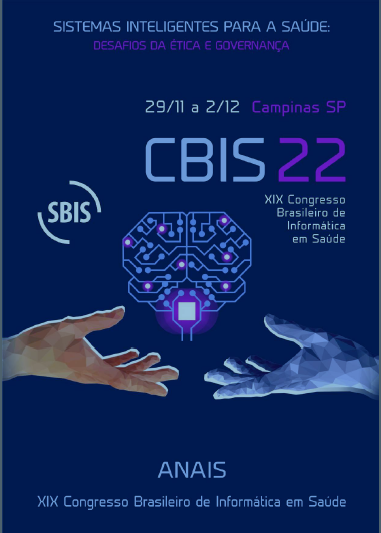Multi-Classification of Electroencephalogram Signals, for Motor Imagination, using Statistical Signal Processing and Deep Learning
DOI:
https://doi.org/10.59681/2175-4411.v15.iEspecial.2023.1107Keywords:
Signal Processing, Deep Learning, ImaginationAbstract
Objectives: The classification of electroencephalogram (EEG) signals is the basis for building systems with a brain-computer interface. Its development is faced with the complexity of EEG signals, which differ from subject to subject, making their classification complex. Therefore, this work aims to compare the performance of an artificial neural network using different signal processing techniques, in the classification of a resting state and two states of motor imagination (MI). Methods: For this work, we used three statistical techniques of signal processing and a Convolutional Neural Network. The database used for the classification consists of the EEG recording of 109 volunteers, made available by Physionet. Result and Conclusion: It was observed that Principal Component Analysis reduced the computational cost without loss of performance in accuracy. However, Independent Component Analysis and Singular Spectral Analysis did not obtain promising results.
Downloads
References
Pfurtscheller G, Da Silva FL. Event-related EEG/MEG synchronization and desynchronization: basic principles. Clinical neurophysiology. 1999 Nov 1;110(11):1842-57.
Pfurtscheller G, Müller GR, Pfurtscheller J, Gerner HJ, Rupp R. ‘Thought’–control of functional electrical stimulation to restore hand grasp in a patient with tetraplegia. Neuroscience letters. 2003 Nov 6;351(1):33-6.
Craik A, He Y, Contreras-Vidal JL. Deep learning for electroencephalogram (EEG) classification tasks: a review. Journal of neural engineering. 2019 Apr 9;16(3):031001.
Kobayashi, T., Kuriki, S., Principal component elimination method for the improvement of S/N in evoked neuromagnetic field measurements. IEEE Transactions on Biomedical Engineering 46, 951-958.
Agarwal S, Zubair M. Classification of Alcoholic and Non-Alcoholic EEG Signals Based on Sliding-SSA and Independent Component Analysis. IEEE Sensors Journal. 2021 Oct 15;21(23):26198-206.
Hendrycks D, Gimpel K. Gaussian error linear units (gelus). arXiv preprint arXiv:1606.08415. 2016 Jun 27.
Congedo M, Barachant A, Bhatia R. Riemannian geometry for EEG-based brain-computer interfaces; a primer and a review. Brain-Computer Interfaces. 2017 Jul 3;4(3):155-74.
Goldberger AL, Amaral LA, Glass L, Hausdorff JM, Ivanov PC, Mark RG, Mietus JE, Moody GB, Peng CK, Stanley HE. PhysioBank, PhysioToolkit, and PhysioNet: components of a new research resource for complex physiologic signals. circulation. 2000 Jun 13;101(23):e215-20.
Gramfort A, Luessi M, Larson E, Engemann DA, Strohmeier D, Brodbeck C, Goj R, Jas M, Brooks T, Parkkonen L, Hämäläinen M. MEG and EEG data analysis with MNE-Python. Frontiers in neuroscience. 2013:267.
Loboda A, Margineanu A, Rotariu G, Lazar AM. Discrimination of EEG-based motor imagery tasks by means of a simple phase information method. International Journal of Advanced Research in Artificial Intelligence. 2014 Oct;3(10)..
Tangermann M, Müller KR, Aertsen A, Birbaumer N, Braun C, Brunner C, Leeb R, Mehring C, Miller KJ, Mueller-Putz G, Nolte G. Review of the BCI competition IV. Frontiers in neuroscience. 2012:55.
Pion-Tonachini L, Kreutz-Delgado K, Makeig S. The ICLabel dataset of electroencephalographic (EEG) independent component (IC) features. Data in brief. 2019 Aug 1;25:104101.
Pion-Tonachini L, Makeig S, Kreutz-Delgado K. Crowd labeling latent Dirichlet allocation. Knowledge and information systems. 2017 Dec;53(3):749-65.
SCCN. (n.d.). SCCN: Independent Component Labeling. Retrieved September 10, 2022, from https://labeling.ucsd.edu/tutorial/labels
Kai Ming Ting. 2011. Encyclopedia of machine learning. Springer. ISBN 978–0–387–30164–8.
Kim TK. Understanding one-way ANOVA using conceptual figures. Korean journal of anesthesiology. 2017 Feb 1;70(1):22-6.
Lawhern VJ, Solon AJ, Waytowich NR, Gordon SM, Hung CP, Lance BJ. EEGNet: a compact convolutional neural network for EEG-based brain–computer interfaces. Journal of neural engineering. 2018 Jul 27;15(5):056013.
Downloads
Published
How to Cite
Issue
Section
License
Copyright (c) 2023 William Henrique Pereira Costa

This work is licensed under a Creative Commons Attribution-NonCommercial-ShareAlike 4.0 International License.
Submission of a paper to Journal of Health Informatics is understood to imply that it is not being considered for publication elsewhere and that the author(s) permission to publish his/her (their) article(s) in this Journal implies the exclusive authorization of the publishers to deal with all issues concerning the copyright therein. Upon the submission of an article, authors will be asked to sign a Copyright Notice. Acceptance of the agreement will ensure the widest possible dissemination of information. An e-mail will be sent to the corresponding author confirming receipt of the manuscript and acceptance of the agreement.





